Meade Distribution
Meade Telescopes
![]() History
History ![]()
![]() Notes & Literature
Notes & Literature ![]() Overview
Overview ![]()
![]()
![]()
![]() Service or Repair
Service or Repair
![]()
Meade Instruments Corporation
LIGHTBRIDGE™ 12 Truss Dobsonian Telescope
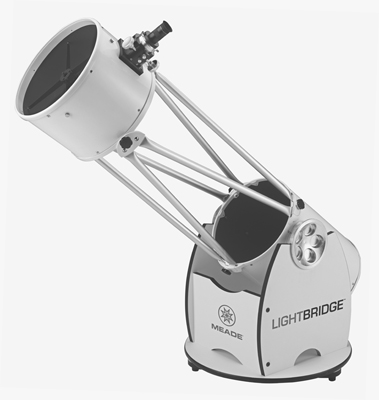 This is our review of the first production Lightbridge™ 12 telescope received by Company Seven and now displayed in our showroom. This telescope came with assembly errors as it was delivered from Meade, and so this telescope simply would not have worked well if it had been put together following the instructions. However, once we resolved the problems we were pleased with the final overall result. There will be subtle modifications made to improve performance by Company Seven on telescopes sold by us that are not discussed here. Company Seven has provided some constructive suggestions to Meade Instruments Corp. and so some changes may be forthcoming.
This is our review of the first production Lightbridge™ 12 telescope received by Company Seven and now displayed in our showroom. This telescope came with assembly errors as it was delivered from Meade, and so this telescope simply would not have worked well if it had been put together following the instructions. However, once we resolved the problems we were pleased with the final overall result. There will be subtle modifications made to improve performance by Company Seven on telescopes sold by us that are not discussed here. Company Seven has provided some constructive suggestions to Meade Instruments Corp. and so some changes may be forthcoming.
COMPANY SEVEN PROMISES A GIANT DOB FOR EVERY SMALL CAR!
Dobson style telescopes promise a great degree of observing satisfaction especially when considering their the moderate cost. Many economical versions of these telescopes have come and gone over recent years, but those sold by Company Seven endure as they are fine tuned and backed by one of the most credible and competent sources of telescopes in the marketplace. For 2006 we add the new Meade Instruments Lightbridge™ to our inventory. This is a new contemporary telescope with great engineering features tweaked by Company Seven and aimed at bringing the deep sky regions within you reach!
Right: The Meade Instruments Lightbridge™ 12 Standard telescope model (37,161 Bytes).
Click on image to see enlarged view (97,806 bytes)
The Lightbridge™ telescopes are designed for those who seek the best possible view of the fainter deep sky celestial objects, balanced with unprecedented portability and ease of use all while on a comparatively modest budget. Available in 8, 10 and 12 inch apertures Company Seven endorses the 12 inch model as making the most sense especially when considering the work involved to assemble these systems. The nearest competitor to the title of "Best Economical Amateur Dob" would those made by Orion Telescopes, either their SkyQuest™ XT 12. It's cousin the XT12 Intelliscope™ adds the capability to locate any of more than 14,000 fascinating celestial objects with a nudge and some pushbutton ease. Each of these telescopes offer much in the way of good performance and features. It has been said by many in our hobby that regardless of bells and whistles "bigger is better" and in practice this is true - as long as you can take the telescope to where you want it, when you want it: this is where Lightbridge™ comes in.
Space Is Infinite, Your Back Seat Is Not!
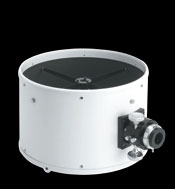
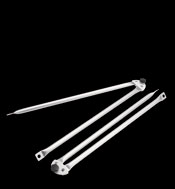
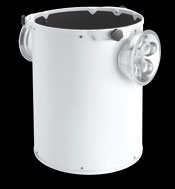

What Characterizes A Newtonian Reflecting Telescope?: It was a Scottish astronomer, James Gregory (1638-1675) who published the first known design for a reflecting telescope in his book Optica Promota of 1663. However, it was Sir Isaac Newton who first made a working model in 1668 and he continued refining the design well into at least 1671. The optical arrangement of the Lightbridge™ employs a Parabolic Primary Mirror working with a smaller Secondary Mirror to gather incoming light; this is known as a "Newtonian" arrangment.
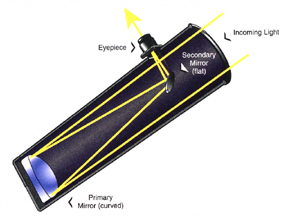 Right: Newtonian reflecting telescope optical arrangement with the incoming light path shown in yellow (38,882 bytes).
Right: Newtonian reflecting telescope optical arrangement with the incoming light path shown in yellow (38,882 bytes).
Click on the image to see enlarged view (187,513 bytes)
The light entering the telescope from the front is gathered by the Primary Mirror and then reflected forward in a converging beam to a Secondary Mirror (an elliptical flat) that is positioned near the front of the telescope and tilted at a 45 degree angle deflecting light to the Focuser. The light cone forms a virtual image at a plane just beyond the focuser. An eyepiece to enlarge the image or a camera for photography is slipped onto the Focuser to view or capture the image.
A well made reflecting telescope offers the best view per the dollar spent of the faint, deep sky objects where light gathering power is essential. The Primary Mirror is the factor by which most reflecting telescopes are described hence a 12 inch telescope has a primary mirror of 12 inch (30 cm) in diameter. Light gathering power increases are more important and come quicker than one may think. Consider how a 6 inch f/8 - a 48 inch (122 cm) long reflecting telescope may show objects about 335X fainter than the unaided eye. While this 12 inch Truss telescope (with similar physical length) provides about 1,400X the light gathering power over the unaided human eye: in astronomy size can matter!
The Dobsonian Telescope: Historically most Newtonian telescope optical tubes were fashioned with a cylindrical tube usually made of wood, fiberglass, metal, or cardboard. By the 1970's a variation of the traditional Newtonian pioneered by San Francisco sidewalk astronomer John Dobson was becoming known. Dobson's goal has been to provide light gathering power in an easier to transport and less costly alternative to the traditional Newtonian arrangement. The Dobson arrangement (also termed "Dobsonian") relies on simple to manufacture materials and techniques. Instead of the unwieldy and heavy German Equatorial Mount traditionally used to support a Newtonian tube, a simple and lighter weight Trunnion and Carriage platform is provided with simple bearing materials to facilitate smooth movement of the optical tube in altitude and azimuth. When made well then this can support the optical tube rigidly and it simplifies set up and use of a telescope.
Furthermore, instead of a full thickness 1:6 ratio Primary Mirror a lighter weight, a thin 1:12 mirror is usually used. This cut the mirror weight about in half and when properly supported, a thin mirror can provide performance rivaling some traditional thick mirrors. The larger mobile Dobson telescopes evolved into truss arrangements where the telescope optical tube is taken apart for transport into sections engineered to be more manageable and portable. The Lightbridge™ are distinguished most importantly by their compact profile and mechanical arrangement which permits quick disassembly of the Optical Tube into smaller components to facilitate transport and assembly in the field.
Lightbridge™ Framework To fashion the upper and lower assemblies which will house the mirrors a thin sheet of steel is rolled into a tube. Aluminum reinforcing rings are fitted onto each end of the assembly. Finally, the two assemblies are held together in the field by six rigid cylindrical alloy 1 inch / 25.4 mm diameter Truss Rods arranged in three pairs. The lower tips of the Rods are attached into six slots in the lower assemblies, and these joints are then secured by three large black plastic hand knobs. The Truss top brackets mate their slots onto the telescope upper assembly, and the remaining three knobs are tightened to secure the Truss in place. This is supposed to provide a telescope that can come apart, then later snap together requiring little if any adjustment to the telescope mirror positioning. Anyone buying a Truss tube reflecting telescope must count on having to learn how to collimate the system or else sooner or later there will be a train wreck..... We will be happy to teach you how to collimate your telescope. Company Seven does also sell precision collimating tools, and our staff will provide private instruction at no additional charge.
The Truss Rods are provided in a dull satin metal finish. The circular aluminum side bearings and other bright aluminum parts are anodized. The metal components of the upper and lower sections are finished internally with an anti reflection flat black paint, with the exterior painted in an appliance white enamel. Since the Truss arrangement exposes the Primary Mirror and to a lesser degree the Secondary Mirror to glaring lights in the vicinity, and increases the possibility of dew or frost build up Company Seven will offer stepped optional solutions for our customers:
- A fitted black Lycra fabric shroud which will surround the Truss rods and block light and mositure from the mirrors, or
- 12 volt DC powered regulated heater elements for the mirrors.
The comparatively thin wall steel construction permits the designer to select a smaller secondary mirror obstruction. This assembled optical tube assembly holds optical collimation well even with temperature or humidity changes. However, Company Seven does not recommend you carry the optical tube assembly by the Truss Rods, instead grip both the upper and lower assemblies. If you intend to carry the assembled Lightbridge™ optical tube then you will find it is more easily managed with our optional padded carrying bag.
The Engine of the Lightbridge™ is a full thickness (1:6 ratio) mirror. The mirrors provided with our first production Lightbridge™ 12 were about on par with what we have experienced coming with telescopes in this price class; certainly enough performance to assure most buyers will be happy for some time to come. At the time this article went on line we had not yet seen more than this example Lightbridge™ and so it would be premature to predict the consistency of the optics. We are pleased that Meade Instruments has provided another trendsetting product, and have provided with it a balance a reasonably good specification with cost. An amateur who seeks even better performance that is most likely to noticed when operating at higher magnifications could procure a replacement mirror set made by a third party - this would be likely to cost as much or more than the entire Lightbridge™ telescope. Or one could have provided mirrors refigured. But these changes are not without some associated risks. Most Dob users will not care about making this 12 inch telescope perform much better if this improvement is costly and obvious only at silly high magnifications - after all one has to manually nudge the telescope along to keep it on a celestial object.
Among the considerations of a well made reflecting telescope are that the mirrors be precisely positioned within the OTA and be adjustable in terms of centering, tilt, and spacing. The proper alignment of the one mirror to the other, and their placing the focal plane (the point where the image comes to focus) at the correct position beyond the focuser are critical. The optical axis of the telescope should be closely parallel to the mechanical axis of the tube assembly too. Company Seven chose to offer this telescope in part because of the good quality of mechanical components and our capability to assemble these telescopes precisely when requested.
Portable Light Gathering Power! The Lightbridge™ 12 provides the light gathering power and fields of view necessary for the clear observing many of the solar system and popular deep sky objects. With about 1,400X the light gathering power of the unaided eye, the Lightbridge™ 12 provides an increase of about 2.3X the light gathering power of the 8 inch reflecting telescopes, and 1.5X that of a typical 10 inch model.
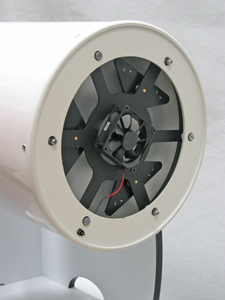 The lower assembly houses the 12 inch f/5 Primary Mirror. This mirror is made to provide good versatility with not only aperture but with a comparatively low inherent magnification. The mirror measures a focal length (measure of the image scale or magnification) of about 1,500 mm so for comparison consider this telescope can show four times the area of sky that an 12 inch f/10 3,000 mm telescope would. Made of stable 2 inch / 50 mm thick Borosilicate Crown glass, this material provides a satisfactory balance of cost with good chemical, thermal, mechanical and optical properties.
The lower assembly houses the 12 inch f/5 Primary Mirror. This mirror is made to provide good versatility with not only aperture but with a comparatively low inherent magnification. The mirror measures a focal length (measure of the image scale or magnification) of about 1,500 mm so for comparison consider this telescope can show four times the area of sky that an 12 inch f/10 3,000 mm telescope would. Made of stable 2 inch / 50 mm thick Borosilicate Crown glass, this material provides a satisfactory balance of cost with good chemical, thermal, mechanical and optical properties.
Left: Bottom of Lightbridge™ telescope Primary Mirror in it's Cell. Note Cooling Fan at center with plug connector at about 7 o'clock; the Fan is provided only with the Lightbridge™ Deluxe version (57,616 bytes).
Click on image to see enlarged view (213,485 bytes).
The Primary Mirror rests on a nine point floatation Mirror Cell with support distributed by means of three groups of three pads across the rear of the Mirror. Three padded restraint clips 120 degrees apart at the front of the Primary Mirror keep it from falling forward or shifting position. The Mirror Cell permits the user to adjust the tilt of the Primary Mirror by means of three screws accessible at the rear for tilt adjustment, while three other screws lock the tilt mechanisms in place.
To facilitate collimation the factory provides a center reference mark on the Primary Mirror. Incidentally, this mark is located at the center of the mirror in an area obstructed from incoming light by the Secondary Mirror and so this mark has no impact on the optical performance. We checked the math regarding this telescope design after we assembled it and found the actual fit of the elliptical Secondary Mirror in both axes to be very close to nominal. The front aluminized surface of the Primary Mirror is protected by a stylish lightweight molded plastic slip on cover.
The Lightbridge™ Deluxe telescopes are provided with a 6 Volt DC powered Cooling Fan positioned so that it draws air across the back of the mirror thus helping to draw heat away from the it. The fan is used only initially to help acclimate the mirror to local temperatures, this should occur within about an hour of taking the telescope out doors. The Cooling Fan set includes a corded battery holder that accommodates four "AA" batteries, the cord plugs into a female socket. The fan has no protective grid so keep loose objects away from the area of the Carriage below the OTA. And also note this Fan is made of fragile plastic, and is vulnerable to impact if the telescope is set aside upright. This fan is not provided on the Lightbridge™ Standard telescopes.
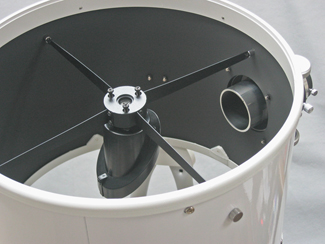 Right: Lightbridge™ telescope "Business End" showing Secondary Spider and Mirror Holder Assembly (57,616 bytes).
Right: Lightbridge™ telescope "Business End" showing Secondary Spider and Mirror Holder Assembly (57,616 bytes).
Click on image to see enlarged view (213,485 bytes).
A Hands-On Telescope Working With Gravity: The Dobsonian is a telescope you can push around - literally. You point it by simply nudging the optical tube on its carriage up or down (altitude), and left or right (azimuth) by hand around a center pivot. Dobsonians are not equatorially mounted and so they are generally moved by hand. The motion on both axes should be smooth letting you guide the scope with just the lightest touch from one part of the sky to another. You do not need to loosen and tighten clamps when targeting objects, as you must with other mounts.
The center of gravity lies low and directly over the center of rotation in both directions of the Carriage, so no matter to where the telescope is pointed the weight is evenly distributed through the mount and down to the ground. This characteristic, and sound design results in almost complete elimination of unwanted vibration and oscillation: the inevitable downfall of many poor telescope mounts. Whereas in many economical telescopes the image seems to bounce around forever after the scope has been touched, this is not the case with well made Dobsonians.
The Dobson design remains the first choice among serious deep sky observers, and it is not uncommon to find custom made "Dobs" of 8 to 36 inch aperture in service at dark sky observing sites around the world. Depending on your goals and budget it may make sense to consider an even larger, more refined truss Dobson style telescope including those by Astro-Systems.
The Carriage of the Lightbridge™ consists of white plastic laminate clad boards that are bolted together easily with the provided hardware. Both 6-¼ inch / 15.9 cm diameter side elevation bearings are provided installed on the optical tube at the factory. These are precisely machined of aluminum, polished so that they glide effortlessly on the 8-¼ inch / 21 cm long strips of felt bearing material glued into the Carriage Fork side cutouts. This arrangement will provide smooth motion of the telescope as long as the felt pads are kept free of sand or other contaminants. The 17 inch / 43.2 cm wide spread of the Lightbridge™'s ¾ inch thick Fork side cutouts translate into good stability translated through the Base Plate, through three 1 inch / 25 mm wide pads to the ground.
While the Lightbridge™ Standard telescopes are provided with Teflon pads for their azimuth bearings, we suggest you pay the difference to buy the Lightbridge™ Deluxe since among its improvements are the substitution of three part metal Azimuth Roller Bearings in place of the Teflon pads provided with the Standard model. These Roller Bearings are notably smoother and provide better longevity than the Tefllon pads.
There is no elevation friction control and so this telescope may at times require the user to employ the tried and true technique of attaching a pouch of lead shot or other weight to counterbalance notably heavy payloads including optional Finders, or heavy eyepieces.
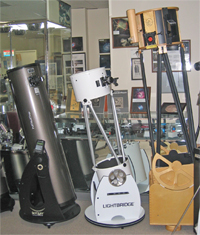 Meade has really set a new standard for portability not only with this Truss arrangement, but with the Carriage of the Lightbridge™ that has so low a profile that it will fit into the trunk of many automobiles. Unlike the 30 inch / 76 cm tall and 26 inch / 66 cm wide Carriage of the Orion XT-12 Intelliscope for example, the Lightbridge™ Carriage is just 20-¾ inches / 52.7 cm tall overall, and at its Base Plate is 25 inches / 63.5 cm in diameter. With the full thickness mirror adding so much ballast low in the tube, one can understand better why the balance point of the Lightbridge™ can be so much lower to the ground than some other Dobson telescopes.
Meade has really set a new standard for portability not only with this Truss arrangement, but with the Carriage of the Lightbridge™ that has so low a profile that it will fit into the trunk of many automobiles. Unlike the 30 inch / 76 cm tall and 26 inch / 66 cm wide Carriage of the Orion XT-12 Intelliscope for example, the Lightbridge™ Carriage is just 20-¾ inches / 52.7 cm tall overall, and at its Base Plate is 25 inches / 63.5 cm in diameter. With the full thickness mirror adding so much ballast low in the tube, one can understand better why the balance point of the Lightbridge™ can be so much lower to the ground than some other Dobson telescopes.
Right: Three 12 inch telescopes displayed at Company Seven (L to R): XT12 Intelliscope™ 12 inch f4.9, Meade Lightbridge™ 12 f5.1 Deluxe,
and an example of a first rate slightly larger Dob - the Astro-Systems 12-½ f5.3. (56,972 bytes).
Click on image to see enlarged view (149,503 bytes).
Fully Machined 2 Inch Crayford Focuser This Focuser is among the more striking looking aspects of the Lightbridge™ telescope. This is a relatively new arrival to the USA with variations of this focuser being provided on some other telescopes coming from China too. The Crayford design takes some practice to get used to since unlike more common Rack and Pinion focusers, this is a friction drive providing frequent tension as well as traditional drawtube lock adjustments. Along the bottom of the Focuser body are the focuser drawtube lock (knob closet to the telescope) with a traditional tension adjustment (knob closet to the eyepiece). The Focus Knobs are machined of aluminum and with a diameter of about 1-7/16 inch 40 mm and are easy to handle even when wearing gloves. The drawtube lock and tension adjustment knobs however are smaller and closer together, so some practice will be needed to manage these with gloves on.
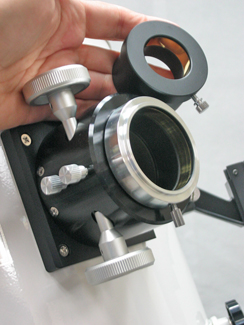 This focuser accepts the heavier low magnification wide field of view 2 inch diameter slip fit eyepieces, and with the provided 2 to 1.25 inch Reducer it also accepts 1.25 inch eyepieces. As a nice touch the male end of the Reducer is machined to accept thread in 48 mm filters so that you can buy one filter for use with both 2 and 1.25 inch accessories but note however, some 2 inch threaded filters including those distributed by Orion may only thread in one turn or so.
This focuser accepts the heavier low magnification wide field of view 2 inch diameter slip fit eyepieces, and with the provided 2 to 1.25 inch Reducer it also accepts 1.25 inch eyepieces. As a nice touch the male end of the Reducer is machined to accept thread in 48 mm filters so that you can buy one filter for use with both 2 and 1.25 inch accessories but note however, some 2 inch threaded filters including those distributed by Orion may only thread in one turn or so.
Left: Lightbridge™ Focuser with its provided 2 to 1.25 inch reducer shown. Note aluminum focuser drawtube lock knob (closet to telescope) and tension adjustment (closet to the eyepiece) knobs (66,675 bytes).
Click on image to see enlarged view (234,603 bytes).
The focuser body is black anodized, the drawtube has a polished aluminum exterior finish while the interior is lined with antireflection baffling threading that is painted flat black to attenuate unwanted reflections. Ball bearings are installed within the focuser body to support the drawtube alignment. The drawtube moves smoothly along the bearings; this is greaseless design and thus will reduce maintenance and reduce contamination of the mechanism. We have observed these focusers on other telescopes in the field and noted how over time the friction of the ball bearing against the drawtube will produce some wearing of the drawtube finish, while noticeable this has no impact on performance.
The drawtube tension adjustment is turned until it is fairly tight so that the drawtube can be drawn in or out by turning the focuser pinion hand knob. The drawtube lock will usually be tightened to prevent it from moving in or out when supporting heavier payloads. It is almost impossible to keep from having to periodically adjust the focuser tension, and even when at its best the user will encounter notable drawtube position movements in or out when installing or removing eyepieces; if you overcome these drawbacks, then the focus movement can be smooth and can be precise. However, most novices will do better with a Rack and Pinion 2 inch focuser like that provided with the Orion Dobs.
There have been a number of popular geared fine focus kits for telescope focusers in recent years. The Starlight Instruments Feather Touch® offered for our Astro-Phyiscs telescopes is one successful example. These accessories provide the capability to achieve very fine tuning of focus, and these may reduce the possibility of introducing unwanted vibrations when using conventional focusers. There are no kits approved by Company Seven for these Crayford Focusers - yet.
As nice as this Focuser is in some ways the base has no mechanism so that a user can easily adjust its tilt to facilitate collimating the telescope. There is a way that one could loosen and then shim the focuser with spacers, but this technique tends to be tedious and inconvenient. The assumption seems to be that the user will be able to render the focal plane parallel to that of an eyepiece field stop - we do not like to assume. If the maker of this focuser for Meade were to provide the capability to adjust the tilt, then it might be easier for some people (with good skills) to refine collimation; on the flip side this could create more opportunities for the inexperienced user to create mischief.
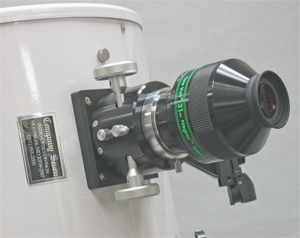 If the Lightbridge™ 12 were equipped only with a 1.25 inch focuser, then the maximum actual Field of View seen would be only 1 degree - about twice the diameter of the full Moon. With 2 inch capability provided for Lightbridge™, a good 35 mm 2 inch eyepiece could provide 1.5 degrees at 44X with a more practical 7 mm Exit Pupil. By using an optional even lower magnification eyepiece then one could reach down to 26X observing areas as large as about 1.7 degrees across; but keep in mind that then the Exit Pupil (diameter of the cone of light coming out of the eyepiece) would be greater than 11 mm and so for most people this will not be as good a choice as using an eyepiece that provides an Exit Pupil of about 7 mm or less. The most desirable high performance low power eyepiece for the Lightbridge™ 12 would be the TeleVue 31 mm Nagler Type 5 eyepiece (nicknamed by the astronomy community the "Terminagler") which would provide 1.6 degrees field of view at 49X with a more practical 6.2 mm Exit Pupil. For most people the Lightbridge™ 12 does reach focus with this monster eyepiece, although some people may need to buy an optional 2 inch extension tube for this and some other 2 inch eyepieces.
If the Lightbridge™ 12 were equipped only with a 1.25 inch focuser, then the maximum actual Field of View seen would be only 1 degree - about twice the diameter of the full Moon. With 2 inch capability provided for Lightbridge™, a good 35 mm 2 inch eyepiece could provide 1.5 degrees at 44X with a more practical 7 mm Exit Pupil. By using an optional even lower magnification eyepiece then one could reach down to 26X observing areas as large as about 1.7 degrees across; but keep in mind that then the Exit Pupil (diameter of the cone of light coming out of the eyepiece) would be greater than 11 mm and so for most people this will not be as good a choice as using an eyepiece that provides an Exit Pupil of about 7 mm or less. The most desirable high performance low power eyepiece for the Lightbridge™ 12 would be the TeleVue 31 mm Nagler Type 5 eyepiece (nicknamed by the astronomy community the "Terminagler") which would provide 1.6 degrees field of view at 49X with a more practical 6.2 mm Exit Pupil. For most people the Lightbridge™ 12 does reach focus with this monster eyepiece, although some people may need to buy an optional 2 inch extension tube for this and some other 2 inch eyepieces.
Left: Lightbridge™ Focuser with optional TeleVue 31 mm Nagler Type 5 eyepiece (49,158 bytes).
Click on image to see enlarged view (207,747 bytes).
Fast focal ratio reflecting telescopes tend to exhibit a subtle optical anomaly that makes stars towards the edge of the field of view appear elongated as though they each have a small tail pointing out and away from the center of the field of view. The average amateur does not see this or know to look for it. This can not be solved by eyepieces however, for those who seek even more perfect images at lower magnifications, consider the TeleVue 2 inch "Paracorr" Coma Correcting Lens. This lens housing resembles a short pipe installed between the focuser and the eyepiece. It will reduce the effects of coma and will simultaneously boost the focal length of this telescope from about 1,524 mm to about 1,550 mm thereby causing some reducing of the field. But more critically, one will have to consider the leverage effect of adding distance between focuser and heavier eyepieces.
The factors of aperture and the 2 inch focuser are particularly important to people who seek better views of the extended, faint deep sky objects (nebulae, star clusters, galaxies, comets, etc.). In effect the stellar magnitude reach is extended from about 13.8 of an 8 inch telescope to about 14.7 with this 12 inch. And still this telescope affords the contrast and clarity qualities required to observe the moon, and planets; the Lightbridge™ actually can reveal changes on the planets throughout the observing season! With a comparatively moderate central obstruction and fewer optical surfaces, the contrast and brightness can actually surpass more expensive designs including 8" and 10" Schmidt-Cassegrain telescopes.
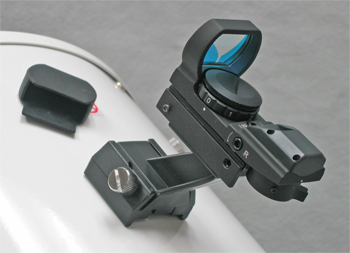 Red Dot Sights The Lightbridge™ Standard telescopes include a simple red dot sight. This is a device that projects a red dot onto a transparent panel giving the appearance of a red dot floating in space ahead of the telescope. Unlike conventional refractive finder telescopes, the sight imparts no magnification and so one can see the entirety of the night sky making it easy to navigate by "star hopping" from one celestial reference point to another with the assistance of a wide angle eyepiece on the telescope. In order to use the Sight one installs it onto the telescope, then point the telescope onto a distant target centering the target in the telescope eyepiece. Now without moving the telescope, turn the sight dial to "on" and carefully adjust the Sight on its bracket up or down, and left or right so that the red dot is pointing directly over the target centered in the eyepiece. Now you can employ Sight along with charts of the night sky to find objects to view in the telescope.
Red Dot Sights The Lightbridge™ Standard telescopes include a simple red dot sight. This is a device that projects a red dot onto a transparent panel giving the appearance of a red dot floating in space ahead of the telescope. Unlike conventional refractive finder telescopes, the sight imparts no magnification and so one can see the entirety of the night sky making it easy to navigate by "star hopping" from one celestial reference point to another with the assistance of a wide angle eyepiece on the telescope. In order to use the Sight one installs it onto the telescope, then point the telescope onto a distant target centering the target in the telescope eyepiece. Now without moving the telescope, turn the sight dial to "on" and carefully adjust the Sight on its bracket up or down, and left or right so that the red dot is pointing directly over the target centered in the eyepiece. Now you can employ Sight along with charts of the night sky to find objects to view in the telescope.
Left: Lightbridge™ Deluxe red illuminated sight with provided rubber slip on cover shown above left (57,002 bytes).
Click on image to see enlarged view (172,681 bytes).
The Lightbridge™ Deluxe telescopes are provided with a more sophisticated red illuminated sight. This sight provides not only alignment adjustments, but brightness control and the choice of four reticle patterns: Red Dot, Cross, Bulls Eye, and Diamond. It is also provided with a protective rubber slip on cover; you might punch a small hole well into the flap of the cover and run a short string from it to the Sight so that the cover is not lost. Observer's may need to keep the sight covered when not in use to prevent dew or frost accumulation, or simply attach one of our Kendrick Dew Prevention Systems. The sight is installed onto the Lightbridge™ by a quick release mechanism and hand knob, so the sight may be quickly removed or installed with no tools.
The Lightbridge™ includes a convenient Accessory Tray which can be attached onto the side of the Carriage. This provides holes fitting as many as three 1.25 inch accessories plus one accessory of 2 inch diameter. Unlike accessory trays by Orion for example where their tray is has two keyhole shaped screw holes (customers may slide it up and out to remove the tray for transport), the Lightbridge™ tray is designed to be left fixed in place so use extra care not to strike it when hauling the Base about. And to keep dew or other contaminants from marring exposed eyepieces Company Seven suggests you keep protective eyepiece caps in place.
This is a telescope that will perform at its best only when the subassembly components are properly made and put together at the factory. Someone with little experience can decipher the translated, illustrated instructions and should be able to obtain satisfactory results. Judging by the assembly errors on this telescope, how far out of alignment the components were before we began to work to align the optics, we are left to surmise that even if the telescope is made well and assembled properly at the factory, some percentage of novices will not be able to assemble and collimate the telescope to obtain its best possible performance without some guidance. For those who seek the best possible result, Company Seven will offer optional assembly services so that you may pickup a complete and ready to go Lightbridge™.
Noteworthy features of the Lightbridge™ Standard telescope include:
-
A set of accessories provided to get you up and running on the first night out!
- Meade 26 mm Series 4000 Super Plössl 1.25 Inch Eyepiece (59X, 0.8 Degree Field of View)
- Red Dot Sight - makes locating objects quick and simple
- Eyepiece Holder with three holes for 1.25" and one for 2" eyepieces or accessories
- Easy On-Off Lightweight Plastic Slip Fit Primary Mirror Cover
-
A set of accessories provided to get you up and running on the first night out!
- Meade 26 mm QX Wide Angle 2 Inch Eyepiece 70 degree apparent field-of view (59X, 1.1 Degree Field of View)
- Advanced Red Dot Sight - dial to select any one of four reticle patterns and adjust brightness
- Three Part Steel Roller Azimuth Bearings (in place of standard Teflon bearing pads)
Innovative Design!
- Fast, compact f/5 design keeps the eyepiece height comfortable for most observers
- Compact profile takes up less space in your vehicle and so you are more likely to take it out
- Portable Truss arrangement with rolled steel tube construction with cast aluminum end rings
- Exterior is finished in durable white enamel, interior in antireflection Black
- Full thickness molded expertly finished Parabolic Primary Mirror made of Borosilicate Crown glass.
- Primary and secondary mirrors are aluminized and over coated with a protective transparent Magnesium Fluoride
- Primary Mirror Cell provides good ventilation for fast cool-down time, spring-loaded collimation thumbscrews
- Optics hand finished and tested to assure diffraction limited performance
- Silky smooth machined 2 Inch Focuser
- Focuser incorporates both drawtube lock and tension adjustments
- Slip Fit 2 to 1.25 inch Reducer, threaded for 48mm Filters
- Focuser and Reducer employ non marring clamps to secure accessories
Lightbridge™ 12 Inch Telescope Specifications*:
|
Maximum Height Overall: Maximum Height to The Eyepiece: Length of Optical Tube Assembly: Wall Thickness: O.A. Diameter of Optical Tube: O.A. Diameter of Front Ring:
Primary Mirror Thickness:
Effective Light Gathering Power:
Focuser Design:
Weight of Optical Tube Assembly:
Sight Battery: |
61-½ inches / 156.2 cm 56-½ inches / 143.5 cm 56-½ inches / 143.5 cm 1/28 inch / 0.9 mm 14 inches / 35.6 cm 14-¼ inches / 36.2 cm
2 inches / 51 mm
Approx. 1,410X that of Human Eye
Crayford Style
45.6 lbs. / 20.73 kg
Lithium CR2032: 20.0 X 3.2 mm, 3 Volts, 200 mAh |
Lightbridge™ 12 Inch Telescope Shipping Dimensions*:
|
Weight of Optical Tube Assembly Carton:
Dimensions of Optical Tube Assembly Carton: |
56 lbs. / 25.5 kg 39 lbs. / 17.7 kg
35 x 20 x 19 inches / 89 x 51 x 48.3 cm |
* Specifications are subject to change without notice.
FURTHER READING
To read additional information about the Lightbridge™ telescopes sold by Company Seven feel free to download the Instruction Manual: 8, 10, 12 Lightbridge™ Truss Tube Dobson Telescopes Instruction Manual. This is the complete 21 page illustrated instruction manual as these Dobsonian telescopes. Includes unpacking instructions, parts list, instructions for the use, maintenance, and typical accessories. Publication content by Meade Instruments, all rights reserved. From Company Seven's Archives. 791,000 bytes (in Acrobat Reader ".pdf" format).
COMPANY SEVEN'S ASSEMBLY & TESTING SERVICES:
The quality of information we provide on line and by phone or E-Mail to the customer, our expertise, our unrivaled showroom and museum (an increasing rare sight), and the fact that one may buy the basic instrument from us or elsewhere at about the same cost should be enough to persuade one to choose Company Seven. However, we do even better, we make it in your interest to buy from us. Meade is getting better at persuading factories overseas produce a good value but once in a while something less than perfect slips by; a part is not glued just right, something is installed a bit off, or a component is damaged in transit. If you receive one of these telescopes and if you know enough to recognize an anomaly then it is a simple matter to call Meade Customer Service (GOOD LUCK!) or Company Seven for a prompt exchange or replacement parts.
-
"a series of subtle improvements that can transform an instrument into something wonderful"
When we assemble a Lightbridge™ we evaluate cosmetics, cleaning it and making some subtle improvements as we go. We assemble the telescope making those first and most time consuming adjustments to assure each optical and mechanical component is nominally installed. We are happy to provide you with the optional tools to collimate a telescope when it becomes necessary (after all some years from now you will probably want to pull the mirror for cleaning) and more importantly we will teach you how best to proceed. As we have worked on so many of these instruments we have developed a good sense of how a properly made and adjusted Focuser should feel. We know the tricks to make the telescope move smoother up and down, left and right. We know how to make it last longer - in fact we sometimes change out some components with superior alternatives. We find the quality control problems however, while we do not expect a "Rolls Royce" fit and finish on these telescopes, we work so that the telescope will perform and look as well as experience shows it can. And as we process the telescope we perform some tests that will reveal to our experienced eye whether or not the optics were made and collimated as they could be. And finally, we generate additional information that is provided to the owner; this will characterize the potential of the telescope for visual applications, and if you ever adapt this telescope for use with an Equatorial Mount we also mention what the Lightbridge™ may accomplish photographically.
One will never read a sad tale from someone who actually bought their telescope at Company Seven. We invite you to attend a Star Watch activity of any regional astronomy club and compare a telescope that bears the Company Seven acceptance label with those from elsewhere. In fact more and more we hear accounts of people at such events who bought their telescope elsewhere being convinced theirs was a great value - until they felt the motion of our telescopes and gazed through the eyepieces we recommended.
Company Seven's customers tend to progress further in the hobby than others. This is in part because we are helping them as we wish someone else would have helped us. We are not archetypical salesmen, instead we are experts who can teach you about the instruments and provide the sincere good counsel.
-
"expert counsel brings value to a transaction, and profit should be the reward for a job well done"
SUGGESTED ACCESSORIES
These are optional accessories that are not included with the telescopes that we highly recommend for your viewing pleasure and long term success:
- Guide book: "Backyard Astronomers Guide" or "Nightwatch" by Terrence Dickinson, or "Starware" by Phil Harrington. For the novice from age 8 to 15 or so up to adult. Good introductions to astronomy, the use of telescopes, and their accessories. Easy introductions to finding ones way around the night sky.
- Telrad illuminated sight: to aid one in finding and centering objects in the main telescope, and learn the sky by "star hopping" from one object to another.
- Planisphere: the easiest way to find what is up in the sky at any given time and date, and an aid to planning future sessions.
- Red LED Flashlight such as the Rigel Skylite to help one set up and use a telescope, and to read charts or a planisphere without adversely impacting the observers night vision.
- Light Shroud: a lightweight, black Lycra fabric cover that can be slipped over the open truss area to form a light baffle. By blocking out off axis light sources this improves background contrast of the night sky. By reducing the volume of humid air passing in contact with the Primary Mirror the shroud helps to keep the Primary Mirror from dewing or frosting over the course of an observing session.
- AstroSystems Collimating tool set, these are provided with good with instructions. Or for those who want a very accurate, and easy to use collimator then we recommend you consider our holographic Glatter Laser Collimator devices; even though documentation is included these devices require some training of the user to obtain best results, and our staff is more than capable to help you learn how to use these.
- Neutral Density and Color Filters to reduce the brightness of the Moon and Planets, and highlight subtle features.
- Sky Light Pollution Rejection Filter to reduce the greenish or golden background glow from city lights and darken the sky background - aid seeing faint Nebulae.
- Improved 2 to 1.25 inch accessory adapter with non-marring clamp to securely hold eyepiece, threaded to accept 48 mm filters so that you will only need to buy one standard size filter for use with either 1.25 or 2 inch eyepieces.
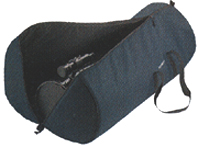
- Padded Carrying Bag: Company Seven provides a padded durable nylon carrying bag with convenient long carrying straps. Two zippers span the cylindrical bag from the bottom to across the top. This bag can be helpful to those who prefer to have their Lightbridge™ optical tube assembled for quick deployment, or simply to keep it arranged in one place. Understand that most Truss telescope arrangements are designed so that the lower side bearings convey the load of the entire optical tube assembly; the Truss Rod and their supporting brackets may be prone to some flexure if either end of the telescope is stressed or jarred in a way in which it was not meant to be used. The bag can keep the telescope clean and safe when it is stored carefully, avoiding undue stress on the Truss and on the bottom of the telescope if the Fan is installed for the Primary Mirror. When you unpack the telescope then the collimation should be checked just prior to use.
- Eyepieces: Meade Instruments includes one eyepiece with this telescope: a 25 mm Plössl is Standard, or a Meade 26mm QX Wide Angle 2 Inch Eyepiece with the Deluxe. Experience shows newcomers to the hobby will initially wish to set up the telescope with at least two or three eyepieces to address:
- Low magnification: for views of the faint deep sky objects a 32mm to 35mm focal length eyepiece.
- Middle Magnification eyepiece - usually between 80 to 120X, for views of the full Moon, Star Clusters, etc.
- High magnification: about 200X or more for views of the planets
Eyepiece designs such as the Plössl and Orthoscopic are acceptable. If you object to less than perfect images particularly at the edge of the field, and if you require long eye relief (distance from lens to the eye) to accommodate spectacles, then Company Seven recommends eyepieces of advanced designs such as those pioneered by Al Nagler, founder of the TeleVue company. TeleVue's advanced designs include the "Nagler", "Radian", or "Panoptic" series eyepieces. These oculars will provide the widest clear, and flat field images bringing out the most in your telescope (and many other) telescopes. Wider field of views are also desirable since as the Earth rotates and objects drift across the field of view, a wide angler ocular shows an object for some time longer before having to adjust the telescope.
Please refer to the brochure and the test report/data from Company Seven enclosed with our telescopes for detailed characterizations of suggested eyepieces:
Eyepiece Magnification Actual field of view Exit pupil 40 mm Plössl 38x 1.0 degrees 8 mm 35 mm Panoptic 43x 1.46 degrees 7 mm 31 mm Nagler 49x 1.6 degrees 6.2 mm 32 mm Plössl 48x 1.0 degrees 6.4 mm 26 QXWA (Deluxe 12) 59x 1.2 degrees 5.2 mm 25 Plössl (Standard 12) 61x 0.7 degrees 5 mm 17 mm Nagler 90x .9 degrees 3.4 mm 14 mm Radian 109x 0.54 degrees 2.8 mm 12 mm Nagler 127x 0.64 degrees 2.4 mm 9 mm Nagler 169X 0.47 degrees 1.8 mm 7mm Nagler 218x 0.4 degrees 1.4mm - Low magnification: for views of the faint deep sky objects a 32mm to 35mm focal length eyepiece.
- Equalizer: A slip fit machined bronze, heavy 2 to 1.25 inch diameter reducer adapter. Helps to keep telescope balance when switching to and from light and heavy accessories and eyepieces.
- Barlow or TeleVue "Powermate" Lens: Company Seven suggests you consider any of a number of 1.25 inch or 2 inch diameter Barlow lenses that we offer to double or more than triple your magnification. Furthermore, these accessories can project an image farther from the focuser to attain focus with most 35mm SLR cameras, optional accessories such as binocular viewers, etc. Contact Company Seven for suggestions on how to to best meet your goals.
- These telescopes put the eyepiece at position that is only about 4 feet (1.2 meters) or so from the ground. Most of our customers are taller than that and so they will find it uncomfortable to stand bent over to observe for extended periods. For a much more enjoyable and comfortable observing experience, Company Seven recommends the Observing Chair; this is our most comfortable, flat folding, adjustable height seat. For easier height adjustment also look at the TeleVue Air Chair. Either is not inexpensive, but each are very practical and can be used for camping or other times when a comfortable portable seat is desired.
The telescope is available packaged as delivered from Meade Instruments, or checked through (assembled then tested and precisely collimated) by Company Seven's experienced staff. While delivery is available, we suggest pickup in our showroom. And of course the Meade Limited Warranty is complimented by Company Seven's own guarantee and service facilities. With proper use and maintenance, there is very little that can go wrong with a telescope such as this - if there is a problem then it is likely we will have found it for you and so with the exception of mirror coatings and wear items such as the felt pads (for which we can provide improved replacements), Company Seven backs any Lightbridge™ telescope we sell against deficiencies for life.